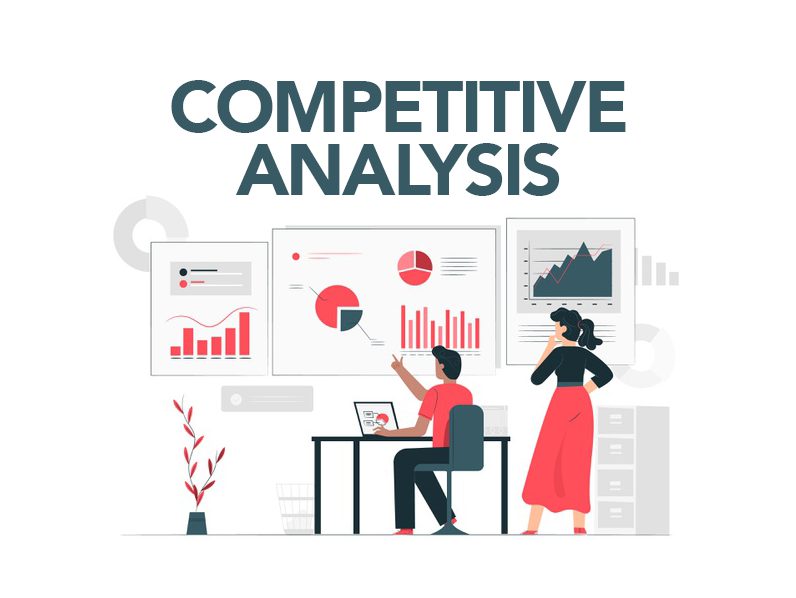Table of Contents

What Does Competitive Analysis for Entrepreneurs Mean?
Competitive analysis for entrepreneurs is an integral part of market research that makes it easy and comprehensive. This is because the success of a business often lies in the ability to connect with leads, foresee their needs, and offer solutions that resonate with their preferences.
Leveraging market research effectively can be the key to reaching your target audience, forging meaningful connections, and driving potential clients through your doors.
Competitive analysis is a subset of market research that involves investigating the strengths and weaknesses of business competitors. It is the process of identifying and evaluating competitors within your niche/industry, their strategies and tactics.
This article will serve as your comprehensive guide to applying the power of competitive analysis for market research to drive potential clients.
READ ALSO: How to Generate Leads for Business Using Advertising (2023)
How to Conduct Competitive Analysis for Startups
A complete competitive analysis should provide your business with a deep understanding of your competitors’ products or services and their marketing approaches. This allows you to determine their strengths for inspiration and their weaknesses for strategic advantage. The following are practical steps to conduct a competitive analysis:
- Identify your competitors: Identify your direct and indirect competitors in your industry or niche.
- Gather Data: Collect data and information about each of your competitors about their products or services, pricing strategies, target customers, demographics, distribution channels, marketing and advertising tactics, online presence, customer reviews and feedback.
- SWOT: Conduct a SWOT analysis for each competitor. Look into their strengths (competitive advantage), weaknesses (vulnerabilities), opportunities and threats.
- Evaluate products or services: A successful competitive analysis for entrepreneurs requires you to evaluate the features, quality, and uniqueness of their products or services compared to yours. Consider any gaps in the market they are addressing.
- Pricing strategies: Analyze their pricing strategies, discounts, and promotions. Are they positioning themselves as market leaders or not?
- Marketing strategies: Appraise their marketing efforts. What channels are they using? What messaging and branding strategies are they employing? How are they engaging with their audience?
- Engagement and reviews: Evaluate their online presence, how they relate with customers and the engagement rate on their website or social media accounts. Pay attention to reviews and feedback about your competitors. This can provide insights into areas where they excel or where customers are dissatisfied.
- Analyse distribution channels: Understand their distribution methods, such as online sales, retail outlets, or other means.
- Strategic Insights: From the information gathered as a result of the competitive analysis for entrepreneurs, draw insights and make well-informed decisions for your startup.
How to Use Competitive Analysis to Find an Advantage
After conducting a competitive analysis, you use the gathered information to make informed decisions and formulate strategies. This might involve leveraging your competitive advantages, addressing market gaps, effectively positioning your product or service, or adapting your business model.
The purpose of competitive analysis for entrepreneurs is to gain an edge in the market by capitalizing on opportunities, mitigating threats, and making your business more responsive to market dynamics.
Conducting the analysis is the research and data collection phase of market research. Using competitive analysis is the strategic phase where you apply the insights gained to shape your business strategy and gain a competitive advantage.
Related: How to do Market Research for Startups
How to Utilize Market Research to Find Customers

Market research for entrepreneurs is a top priority in the chain of business plans. Employing it in strategy for your business helps you understand your target audience and how to reach them effectively. To use market research to find potential clients, here are the steps to follow:
- Conduct Comprehensive Market Research: Start by conducting thorough market research to gather insights about your industry, competitors, and market trends. This foundational step provides the data you need to make informed decisions.
- Define Your Target Audience: Based on your findings, curate a list of attributes, specific demographics, and behaviours of your ideal customers. Consider factors like age, gender, income, interests, and location.
- Segregate your audience: Segregate your target audience into distinct groups based on common characteristics and needs. This allows you to focus your marketing efforts more efficiently.
- Identify High-Potential Segments: Analyze the segmented data to identify which customer segments are the most promising for your business and align your business with their preferences.
- Optimize Your Marketing Strategies: Use marketing strategies that resonate with your target customer segments. Choose the right marketing channels and content that align with their interests and values. Use keyword research tools to identify the search terms and phrases prospective customers use when looking for products or services similar to yours.
- Adopt Effective Communication: Communicate your value proposition clearly and effectively. Ensure that your marketing materials and messages align with what your target customers care about most.
- Leverage Data-Driven Decision-Making: Continuously collect and analyze data, including customer feedback and market trends. Use these insights to refine your understanding of your target customers and make data-driven decisions.
- Monitor and Measure: Regularly monitor the effectiveness of your marketing efforts and customer engagement strategies. Measure key performance indicators (KPIs) to assess how well you are connecting with your target customers.
By following these steps, you can leverage market research to identify the right customers and tailor your products, services, and marketing strategies to effectively reach and engage with them. This increases the chances of building lasting relationships with customers.
Remember that market research is never-ending, and your customers’ preferences can change. Flexibility to such change is essential for long-term success in attracting and retaining customers.
Related: How to use the Right Media Partner for your Business
FAQs
What are the 6 steps of competitor analysis?
The steps include identifying your competitors, gathering information, SWOT analysis, customer insights, market share analysis, and strategic insights.
Is SWOT analysis a competitor analysis?
No, it is not. SWOT analysis is a framework within the context of competitor analysis. SWOT is usually used to assess your competitors to gain an insight into their strengths, weaknesses, opportunities and threats and how you can leverage the findings.
WHAT IS A COMPETITIVE ANALYSIS FOR A NEW BUSINESS
A competitive analysis for a new business involves evaluating and understanding your competitors in the market. It helps you identify strengths and weaknesses in your industry and adjust your business strategy accordingly. Here are the key steps:
Identify Competitors: List all businesses that offer similar products or services in your target market.
Gather Information: Research your competitors’ products, pricing, marketing strategies, and customer base. Online sources, surveys, and direct observations can be valuable.
SWOT Analysis: Conduct a SWOT analysis (Strengths, Weaknesses, Opportunities, Threats) for each competitor and your own business.
Differentiation: Identify how your business can stand out from the competition. What unique value can you offer?
Pricing Strategy: Analyze competitors’ pricing models and determine how yours compares.
Target Audience: Understand your competitors’ customer demographics and tailor your marketing efforts accordingly.
Marketing and Promotion: Analyze their marketing channels and strategies. What works for them, and what can you adapt for your business?
Customer Reviews and Feedback: Examine online reviews and customer feedback to gauge customer satisfaction with competitors.
How to do a business analysis for a small business?
Conducting a business analysis for a small business helps assess its overall health and performance. Here’s how to do it:
Define Objectives: Determine the specific objectives of your analysis. Are you assessing financial performance, marketing effectiveness, or operational efficiency?
Gather Financial Data: Collect financial statements, income statements, balance sheets, and cash flow statements. Analyze revenue, expenses, and profitability.
Market Analysis: Understand your target market, customer demographics, and industry trends. Evaluate your market position and potential for growth.
Competitive Analysis: As discussed in the previous FAQ, analyse your competitors to identify strengths and weaknesses.
SWOT Analysis: Conduct a SWOT analysis for your business to assess internal strengths and weaknesses and external opportunities and threats.
Customer Feedback: Gather customer feedback through surveys, reviews, and direct interactions to gauge satisfaction and areas for improvement.
Operational Efficiency: Evaluate your business processes and identify areas where you can streamline operations and reduce costs.
Marketing Effectiveness: Assess the performance of your marketing strategies and campaigns. Determine which channels are most effective in reaching your target audience.
Legal and Regulatory Compliance: Ensure that your business complies with all relevant laws and regulations in your industry.
Action Plan: Based on your analysis, create an action plan with specific steps and goals to address weaknesses and capitalize on opportunities.
Monitor and Adjust: Continuously monitor your business’s performance and adjust your strategies as needed to achieve your objectives.

